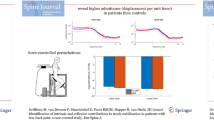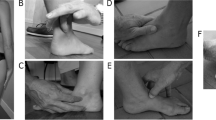Abstract
The purpose of the study was to assess the effectiveness of a specific rehabilitation therapy for chronic non-specific low-back pain patients, based on a random/irregular functional perturbation training induced by force disturbances to the spine. Forty patients (20 controls and 20 in the perturbation-based group) finished the whole experimental design. A random-perturbation exercise, which included variable and unpredictable disturbances, was implemented in the therapy of the perturbation-based group (13 weeks, two times per week and 1.5 h per session). The participants of the control group did not receive any specific training. Low-back pain, muscle strength, and neuromuscular control of spine stability were investigated before and after the therapy using the visual analog scale, maximal isometric and isokinetic contractions, nonlinear time series analysis, and by determining the stiffness and damping of the trunk after sudden perturbations. The perturbation-based therapy reduced patient’s low-back pain (35%), increased muscle strength (15–22%), and trunk stiffness (13%), while no significant changes were observed in the control group. It can be concluded that the proposed therapy has the potential to enhance trunk muscle capability as well as sensory information processing within the motor system during sudden loading and, as a consequence, improve the stabilization of the trunk.





Similar content being viewed by others
References
Anderson JS, Lampl I, Deda I, Gillespie DC, Ferster D (2000) The contribution of noise to contrast invariance of orientation tuning in cat visual cortex. Science 209:1968–1972
Asgari M, Sanjari MA, Mokhtarinia HR, Moeini Sedeh S, Khalaf K, Parnianpour M (2015) The effects of movement speed on kinematic variability and dynamic stability of the trunk in healthy individuals and low back pain patients. Clin Biomech 30:682–688
Beneck GJ, Kulig K (2012) Multifidus atrophy is localized and bilateral in active persons with chronic unilateral low back pain. Arch Phys Med Rehabil 93:300–306
Brown SHM, McGill SM (2009) The intrinsic stiffness of the in vivo lumbar spine in response to quick releases: implications for reflexive requirements. J Electromyogr Kinesiol 19:727–736
Cholewicki J, Simons AP, Radebold A (2000) Effects of external trunk loads on lumbar spine stability. J Biomech 33:1377–1385
Cholewicki J, Silfies SP, Shah RA, Greene HS, Reeves NP, Alvi K, Goldberg B (2005) Delayed trunk muscle reflex responses increase the risk of low back injuries. Spine 30:2614–2620
Cohen J (1988) Statistical power analysis for the behavioral sciences, 2nd edn. Psychology Press, Hove, pp 20–27
de Vlugt E, Schouten AC, van der Helm FCT, Teerhuis PC, Brouwn GG (2003) A force-controlled planar haptic device for movement control analysis of the human arm. J Neurosci Methods 129:151–168
Douglass JK, Wilkens L, Pantazelou E, Moss F (1993) Noise enhancement of information transfer in crayfish mechanoreceptors by stochastic resonance. Nature 365:337–340
Faisal AA, Selen LPJ, Wolpert DM (2008) Noise in the nervous system. Nat Rev Neurosci 9:292–303
Fraser A, Swinney H (1986) Independent coordinates for strange attractors from mutual information. Phys Rev A Gen Phys 33:1134–1140
Freddolini M, Strike S, Lee RYW (2014) Stiffness properties of the trunk in people with low back pain. Hum Mov Sci 36:70–79
Frost DM, Beach TA, Callaghan JP, McGill SM (2015) Exercise-based performance enhancement and injury prevention for firefighters: contrasting the fitness- and movement-related adaptations to two training methodologies. J Strength Cond Res 29:2441–2459
Gildea JE, van den Hoorn W, Hides JA, Hodges PW (2015) Trunk dynamics are impaired in ballet dancers with back pain but improve with imagery. Med Sci Sport Exer 47:1665–1671
Graham RB, Oikawa LY, Ross GB (2014) Comparing the local dynamic stability of trunk movements between varsity athletes with and without non-specific low back pain. J Biomech 47:1459–1464
Granacher U, Lacroix A, Muehlbauer T, Roettger K, Gollhofer A (2013) Effects of core instability strength training on trunk muscle strength, spinal mobility, dynamic balance and functional mobility in older adults. Gerontology 59:105–113
Granata KP, England SA (2006) Stability of dynamic trunk movement. Spine 31:E271–E276
Hides JA, Jull GA, Richardson CA (2001) Long-term effects of specific stabilizing exercises for first-episode low back pain. Spine 26:E243-248
Hodges PW, Tucker K (2011) Moving differently in pain: a new theory to explain the adaptation to pain. Pain 152:S90-98
Hodges P, van den Hoorn W, Dawson A, Cholewicki J (2009a) Changes in the mechanical properties of the trunk in low back pain may be associated with recurrence. J Biomech 42:61–66
Hodges PW, Galea MP, Holm S, Holm AK (2009b) Corticomotor excitability of back muscles is affected by intervertebral disc lesion in pigs. Eur J Neurosci 29:1490–1500
Ikeda DM, McGill SM (2012) Can altering motions, postures, and loads provide immediate low back pain relief: a study of 4 cases investigating spine load, posture, and stability. Spine 37:E1469-E1475
Jeffries LJ, Milanese SF, Grimmer-Somers KA (2007) Epidemiology of adolescent spinal pain: a systematic overview of the research literature. Spine 32:2630–2637
Kantz HA (1994) Robust method to estimate the maximal Lyapunov exponent of a time series. Phys Lett A 185:77–87
Kennel M, Brown R, Abarbanel H (1992) Determining embedding dimension for phase-space reconstruction using a geometrical construction. Phys Rev A 45:3403–3411
Kushner AM, Brent JL, Schoenfeld BJ, Hugentobler J, Lloyd RS, Vermeil A, Chu DA, Harbin J, McGill SM, Myer GD (2015) The back squat part 2: targeted training techniques to correct functional deficits and technical factors that limit performance. Strength Cond J 37:13–60
Lin DC, Rymer WZ (2001) Damping actions of the neuromuscular system with inertial loads: human flexor pollicis longus muscle. J Neurophysiol 85:1059–1066
Liu W, Lipsitz LA, Montero-Odasso M, Bean J, Kerrigan DC, Collins JJ (2002) Noise-enhanced vibrotactile sensitivity in older adults, patients with stroke, and patients with diabetic neuropathy. Arch Phys Med Rehabil 83:171–176
McDonnell MD, Ward LM (2011) The benefits of noise in neural systems: bridging theory and experiment. Nat Rev Neurosci 12:415–426
Mirbagheri MM, Barbeau H, Kearney RE (2000) Intrinsic and reflex contributions to human ankle stiffness: variation with activation level and position. Exp Brain Res 135:423–436
Mori T, Kai S (2002) Noise-induced entrainment and stochastic resonance in human brain waves. Phys Rev Lett 88:218101
Priplata AA, Niemi JB, Harry JD, Lipsitz LA, Collins JJ (2003) Vibrating insoles and balance control in elderly people. Lancet 362:1123–1124
Radebold A, Cholewicki J, Panjabi MM, Patel TC (2000) Muscle response pattern to sudden trunk loading in healthy individuals and in patients with chronic low back pain. Spine 25:947–954
Reeves NP, Cholewicki J, Lee AS, Mysliwiec LW (2009) The effects of stochastic resonance stimulation on spine proprioception and postural control in chronic low back pain patients. Spine 34:316–321
Ross GB, Mavor M, Brown SHM, Graham RB (2015) The effects of experimentally induced low back pain on spine rotational stiffness and local dynamic stability. Ann Biomed Eng 43:2120–2130
Shu Y, Hasenstaub A, Badoual M, Bal T, McCormick DA (2003) Barrages of synaptic activity control the gain and sensitivity of cortical neurons. J Neurosci 23:10388–10401
Steele J, Bruce-Low S, Smith D (2015) A review of the specificity of exercises designed for conditioning the lumbar extensors. Br J Sports Med 49:291–297
Stuge B, Laerum E, Kirkesola G, Vøllestad N (2004) The efficacy of a treatment program focusing on specific stabilizing exercises for pelvic girdle pain after pregnancy: a randomized controlled trial. Spine 29:351–359
Tsao H, Hodges PW (2007) Immediate changes in feedforward postural adjustments following voluntary motor training. Exp Brain Res 181:537–546
Tsao H, Hodges PW (2008) Persistence of improvements in postural strategies following motor control training in people with recurrent low back pain. J Electromyogr Kinesiol 18:559–567
Tsao H, Tucker KJ, Hodges PW (2011) Changes in excitability of corticomotor inputs to the trunk muscles during experimentally-induced acute low back pain. Neuroscience 181:127–133
van Dieën JH, van Drunen P, Happee R (2017) Sensory contributions to stabilization of trunk posture in the sagittal plane. J Biomech. doi:10.1016/j.jbiomech.2017.07.016
Willemink MJ, van Es HW, Helmhout PH, Diederik AL, Kelder JC, van Heesewijk JP (2012) The effects of dynamic isolated lumbar extensor training on lumbar multifidus functional cross-sectional area and functional status of patients with chronic nonspecific low back pain. Spine 37:E1651-E1658
Willigenburg NW, Kingma I, Hoozemans MJM, van Dieen JH (2013) Precision control of trunk movement in low back pain patients. Hum Mov Sci 32:228–239
Winter DA (2009) Biomechanics and motor control of human movement. Wiley, Hoboken, p 86
Wu G, Siegler S, Allard P, Kirtley C, Leardini A, Rosenbaum D, Whittle M, D’Lima DD, Cristofolini L, Witte H, Schmid O, Stokes I (2002) ISB recommendation on definitions of joint coordinate system of various joints for the reporting of human joint motion—part I: ankle, hip, and spine. J Biomech 35:543–548
Acknowledgements
The present study was funded by the German Federal Institute of Sport Science on behalf of the Federal Ministry of the Interior of Germany as the major funder. It is realized within MiSpEx—the National Research Network for Medicine in Spine Exercise (Grant Number 080102A/11-14). We declare that the results of the study are presented clearly, honestly, and without fabrication, falsification, or inappropriate data manipulation.
Author information
Authors and Affiliations
Corresponding author
Ethics declarations
Conflict of interest
None to declare.
Additional information
Communicated by Benedicte Schepens.
Rights and permissions
About this article
Cite this article
Arampatzis, A., Schroll, A., Catalá, M.M. et al. A random-perturbation therapy in chronic non-specific low-back pain patients: a randomised controlled trial. Eur J Appl Physiol 117, 2547–2560 (2017). https://doi.org/10.1007/s00421-017-3742-6
Received:
Accepted:
Published:
Issue Date:
DOI: https://doi.org/10.1007/s00421-017-3742-6




